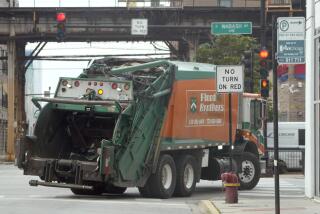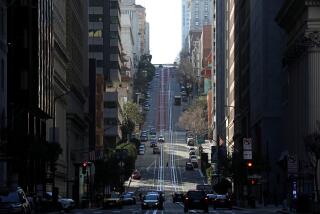Don’t Be Left in the Dark on Left-Turn Signal--Read On
- Share via
Dear Readers:
Street Smart takes a look at left turns this week, having received several related questions recently. So read on, and find out--once and for all--what a “protective-permissive” left-turn signal is.
Dear Street Smart:
Over the past 20 years or so, Southern California traffic planners have created thousands of “Left Turn on Arrow Only” intersections. As a result, thousands of times a day, motorists are forced to wait for a signal change to make a turn when there is no opposing traffic.
Most of these intersections could be changed so that the green arrow would come on and clear out the turn pocket, then allow legal left turns when oncoming traffic safely permitted.
I don’t know to whom such a suggestion should be addressed.
If there is a central planning point for this type of information, could you forward the idea?
Failing that, if you have a list of such planners, I would be happy to write to each one.
Donald A. Woodmancy, Laguna Niguel
The type of signal you’re asking for exists and has grown in use throughout Southern California in recent years. It is known as the “protective-permissive” left-turn signal, and it’s a recurring Street Smart topic because motorists are sometimes confused by it.
A protective-permissive signal first gives motorists a green arrow, indicating that they may make a left turn protected against opposing traffic. When the protective phase ends, a green light appears, signaling that cars may turn left when traffic allows.
The signals have been around for a while, but the evolution of traffic in Southern California is making them more popular, explained Don Dey, Anaheim’s principal traffic engineer. His city has installed about 25 protective-permissive signals since mid-1989.
Imagine the “old days,” when traffic was light and intersections didn’t have left-turn pockets. Then traffic got heavy, so protective left-turn signals were installed to make things safer. But then traffic got really heavy. To keep things moving, cities gave a bigger “slice” of signal time to through traffic by stealing seconds from the left-turn pockets, Dey said.
Now we seem to be moving into a new phase, where cities are installing signals that both protect drivers and allow them flexibility to turn when safe.
That’s what happened in Anaheim. The city wanted to have a protective arrow system during peak hours. But “the other 20 hours of the day, it wasn’t necessary,” Dey said.
The protective-permissive signals offered a convenient solution. Other cities have the dual signals. But Anaheim chose an unusual side-by-side lens arrangement and special signs to better alert drivers to the signal’s double nature, Dey said.
Another city, Irvine, doesn’t have any of the signals yet. But they may be coming. The city is currently eliminating unnecessary left-turn signals from some intersections and will install protective-permissive signals in some others, said Arya Rohani, Irvine’s manager of transportation services.
By the way, a central planning point doesn’t really exist. You could try addressing your comments to either Caltrans or the Orange County Transportation Authority, but contacting local planners about particular intersections probably would be more effective.
Dear Street Smart:
I notice several ways in which left-turn lanes are marked and controlled. Most have a familiar arrow diagram and the words “Left or U-Turn on Green Arrow Only.” These seem simple enough to understand.
But at many other intersections, I have noticed variations. One sign has arrows indicating left turns and U-turns are allowed but no accompanying wording. At other intersections, I find a signal-controlled left-turn lane with no signs whatsoever. Why the differences? The California Vehicle Code should apply equally in all areas.
To compound the situation, one of my children recently attended traffic school and was informed by the California Highway Patrol officer teaching the class that in left-turn lanes without regulatory signs, it is perfectly legal to turn on the red light once you have come to a full stop and oncoming traffic is clear.
It is no wonder driving in California is confusing when there is no uniformity and you are given conflicting information by people who are supposed to be in the know.
Al Schriver, Santa Ana
It may seem a confusing world out there, sign-wise, but you won’t go wrong if you remember this rule: Obey signs over signals.
“Whenever there’s a doubt, and signs are in place, they take the priority,” said Arya Rohani, the Irvine transportation official heard from earlier. “If you do not have any signs prohibiting a U-turn, then you can go ahead and make a U-turn.”
Cities must install signs when they forbid a turn, but cities are not required to install signs telling motorists what they can do.
Now, about that traffic school advice: It’s wrong. You cannot turn left against a red light, unless the light is flashing, and you have stopped first.
Dear Street Smart:
Whenever a bus is at the stop on southbound Main Street, just past 17th Street, cars turning left from 17th have nowhere to go. Regularly during the morning rush hour, Orange County Transit District buses not only stop to pick up passengers, they also stop to do who knows what! I do not know if the drivers are taking coffee breaks or simply waiting for their schedules to match their location. Whatever the reason, such a circumstance poses a genuine hazard.
Michael F. Currier, Orange
Fear not, it should get better soon. Mona Ziada, a district spokeswoman, said the stop will be moved farther south, possibly within weeks, when the company that owns the bus shelter moves the structure.
The Mystery Signal
Some motorists are confused by “protective-permissive” left-turn signals, which first allow left turns protected against opposing traffic, then allow left turns whenever opposing traffic is clear.
Four-Lamp Signal: Green arrow allows protected turn, then green light permits turn when safe. Ordinary left-turn signal changes to red light or red arrow.
Five-Lamp Signal: Operates like four-lamp signal, except a yellow caution arrow indicates that the protective turn phase is ending.
Cluster Signal: Protective turn arrows are on the left side, then right side lights permit turns when safe.
More to Read
Sign up for Essential California
The most important California stories and recommendations in your inbox every morning.
You may occasionally receive promotional content from the Los Angeles Times.










